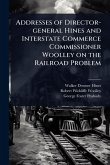This is the Statement of Walker D. Hines, presented before the Railroad Securities Commission in New York on December 22, 1910. Walker Downer Hines (1870-1934) was a prominent American lawyer and railroad executive. He served as Director General of Railroads during World War I and later as president of the New York Cotton Exchange. This statement provides valuable insight into the financial aspects of the railroad industry in the early 20th century, reflecting the concerns and perspectives of the time. It offers a contemporary viewpoint on railroad securities, investment, and regulation, making it a useful resource for those studying American economic history and the development of the transportation sector. This work has been selected by scholars as being culturally important, and is part of the knowledge base of civilization as we know it. This work was reproduced from the original artifact, and remains as true to the original work as possible. Therefore, you will see the original copyright references, library stamps (as most of these works have been housed in our most important libraries around the world), and other notations in the work. This work is in the public domain in the United States of America, and possibly other nations. Within the United States, you may freely copy and distribute this work, as no entity (individual or corporate) has a copyright on the body of the work. As a reproduction of a historical artifact, this work may contain missing or blurred pages, poor pictures, errant marks, etc. Scholars believe, and we concur, that this work is important enough to be preserved, reproduced, and made generally available to the public. We appreciate your support of the preservation process, and thank you for being an important part of keeping this knowledge alive and relevant.
Bitte wählen Sie Ihr Anliegen aus.
Rechnungen
Retourenschein anfordern
Bestellstatus
Storno








